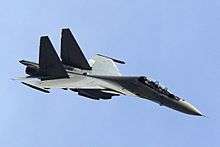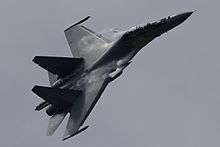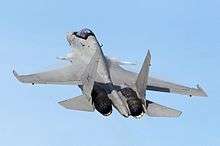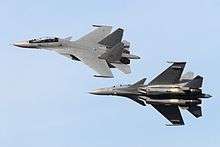Sukhoi Su-30MKM
The Sukhoi Su-30MKM (Russian: Модернизированный Коммерческий Малайзийский/Modernizirovannyi Kommercheskiy Malayziyskiy – Modernized Export Malaysia; NATO reporting name: Flanker-H) is a supermaneuverable fighter of the Royal Malaysian Air Force. It is a variant of the Su-30 series fighters, with many significant improvements over the original Su-30MK export version.[2] The Su-30MKM was developed by the Sukhoi Design Bureau and is based on the Su-30MKI of the Indian Air Force. Both aircraft have common airframe, thrust vectoring engines and digital fly-by-wire system, However the MKM version differs from the MKI mainly in the composition of the onboard avionics.[1] It can carry up to 8,000 kg (17,637 lb) payload over a 1,296 km (805 mi; 700 nmi) un-refueled combat radius.[2]
| Su-30MKM | |
|---|---|
| A Royal Malaysian Air Force Su-30MKM | |
| Role | Air superiority fighter/Multirole fighter |
| National origin | Russia |
| Manufacturer | Irkut Corporation |
| Designer | Sukhoi |
| First flight | August 2003 |
| Introduction | 2007 |
| Status | In service |
| Primary user | Royal Malaysian Air Force |
| Number built | 18 |
| Unit cost |
US$35–53 million |
| Developed from | Sukhoi Su-30 Sukhoi Su-30MKI[1] |
In 2003, the Su-30MKM was selected by the Royal Malaysian Air Force (RMAF). In August 2003, during the course of President Vladimir Putin's official visit to Malaysia, the contract for the Su-30MKM aircraft was signed. Except for Russian MiG-29s, the RMAF has previously operated aircraft of Western origin. At the time of delivery the Su-30MKMs were the most advanced and heavy fighters in Southeast Asia.
Development

In August 2003, Malaysia signed a US$900 million contract with Irkut Corporation for 18 Sukhoi Su-30MKMs. Malaysia operates 8 legacy F/A-18D Hornet, and was offered Boeing's F/A-18E/F Super Hornet, but the Royal Malaysian Air Force chose the Su-30MKM instead. The Su-30MKM is an advanced variant, with considerable performance related improvements over its Su-30MK/MKK counterparts.[3] Irkut Corporation subcontracted the task of manufacturing the canards, stabilizers and fins to Hindustan Aeronautics Limited.[4] As part of the contract agreement, Russia sent the first Malaysian cosmonaut to the International Space Station. It was a project initiated under the government-to-government offset agreement through the purchase of Su-30MKM fighter jets for the Royal Malaysian Air Force. Under this agreement the Russian Federation bore the cost of training two Malaysians for space travel and for sending one to the International Space Station (ISS) in October 2007 under the Angkasawan program.[5]
The first two aircraft were handed over to the RMAF on May 2007 at Irkut's aircraft manufacturing facility at Irkutsk, Russia. The two aircraft were later delivered to RMAF Gong Kedak, Malaysia on June 2007 by an An-124-100 transport aircraft. By December 2007, seven months after the delivery of the first two aircraft, the RMAF had taken delivery of six Su-30MKMs. The eighteenth and last aircraft arrived at RMAF Gong Kedak on August 2009.[6]
In 2016, Su-30MKM succeessfully dropped a Paveway II laser guided bomb in a firing exercise. An aircraft registered number M52-08 successfully dropped the bombs at Kota Belud firing range in Sabah in 27 November 2016.[7]
Design

The Su-30MKM was developed by the Sukhoi Design Bureau and is based on the Su-30MKI. The MKM version differs from the MKI mainly in the composition of its onboard avionics. Thales supplies the Head-up display (HUD), navigational forward-looking IR system NAVFLIR and the Damocles targeting pod. The aircraft carries missile approach warning sensor (MAWS) and laser warning sensor (LWS) manufactured by Avitronics (South Africa).[1] It can carry up to 8,000 kg/ 17,650 lb of weapons and payloads over 700 nmi unrefueled combat radius.[2]
"The Su-30MKM can legitimately claim super-maneuverability via digital fly-by-wire, canards", and two Saturn AL-31FP engines with thrust vectoring "producing 27,500 lb thrust each with afterburners. This gives them an edge in close-in dogfights, allowing the pilot to rapidly point the plane at potential targets to draw them within the AA-11/R-73 Archer’s wide infrared seeker cone, then launch and quickly change energy state and direction".[2]
The electronic warfare (EW) systems, phased array radars, optical-location systems with laser rangefinder were all produced by leading Russian manufacturers. At that time, officers from RMAF formed a Su-30MKM Project Team which was based in Moscow; the team had actively participated in the integration of all the avionics systems.[1] The aircraft is capable of conducting SEAD mission when equipped with two KNIRTI SAP-518 jamming pods and Kh-31P anti-radiation missiles. The KNIRTI SAP-518 covers NATO surface-to-air and air-to-air threats in the G-J bands.[8] It is equipped with NIIP N011M phased array radar for long range aerial combat which can track up to 15 targets and engage 4 targets simultaneously. It can also be equipped with a Thales Damocles Laser Designation Pod (Thales) surveillance & targeting pod for precision ground attack. It has a rear-facing radar, HUD (Thales), NAVFLIR (Navigation Forward Looking Infra-red) (French). Missile Approaches Warning System (MAWS) & laser warning sensor (LWS) supplied by Saab Avitronics of South Africa.[9]
Operators
- Royal Malaysian Air Force has 18 Su-30MKMs in inventory.[10] All the aircraft are assigned to the 12th Squadron based at RMAF Gong Kedak.[11][12]
Specifications (Su-30MKM)


Data from Irkut Corporation,[13] Sukhoi[14]
General characteristics
- Crew: 2
- Length: 21.935 m (72 ft 0 in)
- Wingspan: 14.7 m (48 ft 3 in)
- Height: 6.36 m (20 ft 10 in)
- Wing area: 62 m2 (670 sq ft)
- Empty weight: 18,400 kg (40,565 lb) [15]
- Gross weight: 26,090 kg (57,519 lb) typical mission weight[13]
- Max takeoff weight: 38,800 kg (85,539 lb)
- Powerplant: 2 × Lyulka AL-31FP afterburning turbofan engines, 123 kN (28,000 lbf) with afterburner
Performance
- 1,350 km/h (840 mph; 730 kn) / M1.09 at low altitude
- Range: 3,000 km (1,900 mi, 1,600 nmi) at high altitude[13]
- 1,270 km (790 mi; 690 nmi) at low altitude
- Ferry range: 8,000 km (5,000 mi, 4,300 nmi) with two in-flight refuellings[14]
- Service ceiling: 17,300 m (56,800 ft)
- g limits: +9g
- Rate of climb: 300 m/s (59,000 ft/min) +
- Wing loading: 401 kg/m2 (82 lb/sq ft)
- Thrust/weight: 0.96
Armament
- Guns: 1 × 30 mm Gryazev-Shipunov GSh-30-1 autocannon
- Hardpoints: 12 hardpoints (2 × wingtip AAM rails, 6 × under-wing pylons, 2 × pylon under-engine nacelles, and 2 × pylons in tandem in the "arch" between the engines. It can be increased to 14 using multiple ejector racks.) with a capacity of up to 8,130 kg (17,920 lb),with provisions to carry combinations of:
- Rockets:
- 4 × B-8 rocket pods for 80 × S-8 rockets
- 4 × B-13 rocket pods for 20 × S-13 rockets
- Missiles:
- Bombs:
- 8 × KAB-500L laser-guided bombs
- 3 × KAB-1500L laser-guided bombs
- 8 × FAB-500T bombs
- 28 × OFAB-250-270 bombs
- 32 × OFAB-100-120 bombs
- 4 × GBU-12 Paveway II laser-guided bomb
- Rockets:
Avionics
- Bars N011M passive electronically scanned array radar
- SAP-518 electronic countermeasure pod
- MAW-300 Missile Approach Warning System
- RWS-50 Radar Warning Receiver
- LWS310 Laser Warning System
See also
Related development
Related lists
- List of fighter aircraft
- List of aircraft of the Royal Malaysian Air Force
References
- "Archived copy". Archived from the original on 2008-03-07. Retrieved 2008-03-07.CS1 maint: archived copy as title (link)
- "Malaysias SU-30MKMs Will a New Competition Bring More?". Retrieved 4 April 2018.
- "NBC News - Breaking News & Top Stories - Latest World, US & Local News". Retrieved 4 April 2018.
- "The Su-30MKI Info Page - Vayu Sena". vayu-sena.tripod.com. Retrieved 4 April 2018.
- http://www.angkasa.gov.my/index.php?option=com_content&task=view&id=190&Itemid=258
- Hillebrand, Niels. "MILAVIA Aircraft - Sukhoi Su-27 Flanker Operators". www.milavia.net. Retrieved 4 April 2018.
- https://www.defensenews.com/air/2017/06/15/malaysia-adapts-russian-built-jets-to-drop-us-made-bombs/
- "Sukhoi Malaysia Dilengkapi Knirti". November 12, 2013.
- "Archived copy" (PDF). Archived from the original (PDF) on 2014-12-09. Retrieved 2015-01-21.CS1 maint: archived copy as title (link)
- "World Air Forces 2019". Flightglobal Insight. 2019. Retrieved 2 March 2019.
- "Sukhoi, Malaysia Sign $100 Mln Deal on Fighters' Maintenance". March 28, 2013.
- "Malaysia Invests In Sukhoi Fighter Readiness". June 28, 2013.
- Su-30MK performance (in Russian), Irkut, retrieved 30 April 2015
- "Su-30MK Aircraft performance page." Archived 2011-07-16 at the Wayback Machine Sukhoi. Retrieved: 1 January 2015.
- Hillebrand, Niels, "Sukhoi Su-27 Flanker Specifications", milavia, Niels Hillebrand, retrieved 16 December 2010
External links
| Wikimedia Commons has media related to Sukhoi Su-30MKM. |